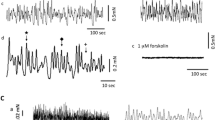Summary
In response to quick stretch, contraction is elicited in longitudinal retractor muscles of five tested species of holothurians, and in the pharyngeal retractor ofCucumaria. The effects of amplitude of stretch and rate of stretch are additive. Rates of contraction and repetitiveness of response, and spontaneous rhythmicity (especially in muscles ofLeptosynapta), correlate with mode of life.
Contractile responses to stretch are abolished by anesthesia with procaine or magnesium. Responses are enhanced by physostigmine or prostigmine, blocked by d-tubocurarine. Responses to electric shocks persist after block of responses to stretch and after block of spontaneous activity by anesthesia, by cholinergic blockers or by Na replacement. Responses to both stretch and shock are abolished by reducing calcium or by agents which block Ca-conductance.
It is postulated (1) that quick stretch stimulates the terminals of cholinergic nerves, (2) that conduction in these nerve fibers is by Na but is TTX resistant, (3) that the nerve endings activate conductance increase for Ca++ in muscle fibers which initiate contractions.
No muscle potentials were recorded by suction or pressure electrodes and no nexal junctions were observed between muscle fibers. The muscles were well innervated and synaptic endings and some neural somata were seen in the nerve bundles.
Similar content being viewed by others
References
Baccetti, B., Rosati, F.: On the thick filaments of holothurian muscles. J. Microsc.7, 455–458 (1968)
Cobb, J.L.S.: Observations on the electrical activity within the retractor muscles of the lantern ofEchinus esculentus using extracellular recording electrodes. Comp. Biochem. Physiol.24, 311–315 (1968)
Cobb, J.L.S.: An ultrastructural study of the dermal papulae of the starfish,Asterias rubens with special reference to innervation of the muscles. Cell Tissue Res.187, 515–523 (1978)
Cobb, J.L.S., Pentreath, V.W.: Anatomical studies of simple invertebrate synapses utilizing stage rotation electron microscopy and densitometry. Tissue and Cell9, 125–135 (1977)
Dolder, H.: An ultrastructural and cytochemical study of neuromuscular junctions in echinoderms. Histochemistry44, 313–322 (1975)
Florey, E., Cahill, M.A.: Ultrastructure of sea urchin tube feet. Cell Tissue Res.177, 195–214 (1977)
Florey, E., Cahill, M.A., Rathmayer, M.: Excitatory actions of GABA and of acetylcholine in sea urchin tube feet. Comp. Biochem. Physiol.51C, 5–12 (1975)
Jensen, H.: Ultrastructure of the dorsal hemal vessel in the sea cucumberParastichopus tremulus (Echinodermata, Holothuroidea). Cell Tissue Res.160, 355–369 (1975)
Pentreath, V.W., Cobb, J.L.S.: Neurobiology of echinodermata. Biol. Rev.47, 363–392 (1972)
Pople, U., Ewer, D.W.: Studies on myoneural physiology of Echinodermata. I. Pharyngeal retractor muscle ofCucumaria sykion. J. Exp. Biol.31, 114–126 (1954)
Pople, U., Ewer, D.W.: II. Circumoral conduction inCucumaria. J. Exp. Biol.32, 59–69 (1955)
Prosser, C.L., Curtis, H.J., Travis, D.M.: Action potentials from some invertebrate non-striated muscles. J. Cell. Comp. Physiol.38, 299–320 (1951)
Prosser, C.L.: Activation of a non-propagating muscle inThyone. J. Cell. Comp. Physiol.44, 247–254 (1954)
Sobieszek, A.: The fine structure of the contractile apparatus of the anterior byssus retractor muscle ofMytilus edulis. J. Ultrastruct. Res.43, 313–343 (1973)
Twarog, B.M., Hidaka, T., Yamaguchi, H.: Resistance to tetrodotoxin and saxitoxin in nerves of bivalve molluscs. Toxicon10, 273–278 (1972)
Author information
Authors and Affiliations
Additional information
Thanks are due to Dennis Willows, director and to staff, University of Washington Laboratories, Friday Harbor; to C.L. Singla of the University of Victoria for preparing and examining electron micrographs; to J.L.S. Cobb for commenting on electron micrographs; to Richard Meiss for designing and constructing ramp stretching device. C. Ladd Prosser was supported by NIH grant 5-R01 AM 12768-10 and George O. Mackie by grant no. A 1427, Nat. Sci. and Eng. Res. Council of Canada.
Rights and permissions
About this article
Cite this article
Prosser, C.L., Mackie, G.O. Contractions of holothurian muscles. J. Comp. Physiol. 136, 103–112 (1980). https://doi.org/10.1007/BF00656906
Accepted:
Issue Date:
DOI: https://doi.org/10.1007/BF00656906



